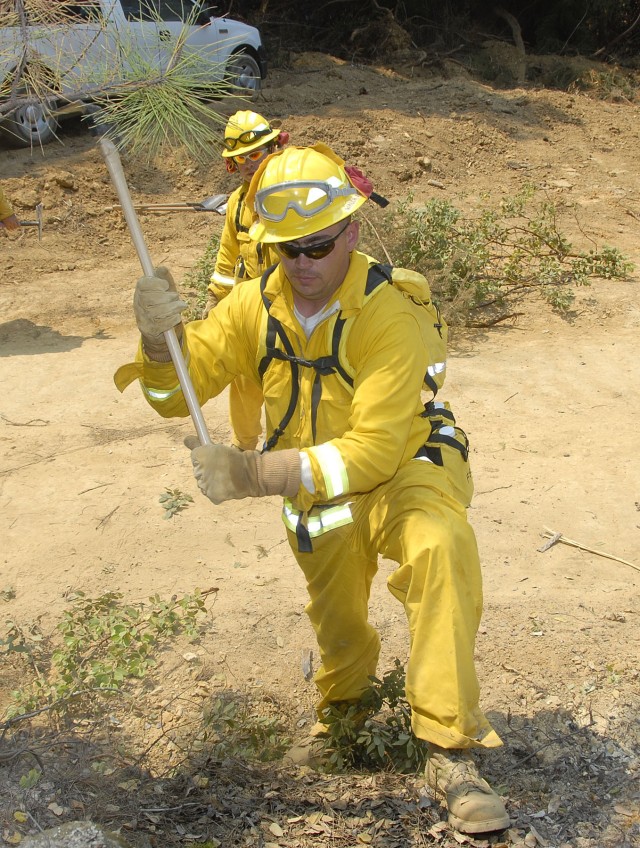
SACRAMENTO, Calif. (Army News Service, July 14, 2008) - An additional 2,000 National Guard troops were ordered to state active duty by Gov. Arnold Schwarzenegger Friday to boost the state's ongoing firefighting efforts and prepare for the threat of additional fires over the next several months, according to a press release from his office.
"We already have 400 Guardmembers on the front lines, and once these new troops are trained and certified, they will be ready to pitch in at a moment's notice throughout the fire season," Schwarzenegger said.
On July 10, the federal government also committed to sending out-of-state firefighters to train these additional California Guard personnel on critical firefighting techniques.
"Having their assistance is going to be critical as we go forward into this summer of fire fighting," said CAL FIRE Capt. Mark Whaling. "They have the same basic fire training that every new firefighter has, so if any of these fires escape their containment lines they will be able to control them so we can get the tired crews back to base camps for rest."
These additional troops will go through training here at McClellan Air Park with the U.S. Forest Service and will be available for duty over the next few weeks.
"The Soldiers will be doing duties that CAL FIRE regularly does. It's just that the volume of fire this year is so much with so many fires ... this is the challenge the Guard will help us meet," Whaling said.
CAL FIRE trained the Guardmembers on fire breaks, brush clearing, proper tool usage and safety. The troops also received basic conditioning that consisted of trail hikes in full gear, in the hot sun, multiple times a day, to prepare for what promises to be very difficult work ahead.
"It's a great experience so far. There is a definite science and process to firefighting that you don't know about until you've been on a hand crew out here for a while," said Sgt. Mark Walch.
Walch is a high school teacher in Chico and a Soldier with Alpha Company, 297th Support Battalion, who dropped the summer classes he was taking and reported to the Oroville Armory within hours of the mobilization.
"The fires in Butte County are threatening my hometown of Paradise, so it's doubly important to me to be here. I'm a small cog in the wheel but every little thing counts," Walch said.
The Soldiers will be grouped into 20-person teams and distributed around the state to wherever the fire officials need them and where the Soldiers can be used most effectively and safely.
'These types of fires are an endurance race, so they will help us stretch our resources so we can move forward and contain the existing and new fires as they pop up," Whaling said.
One CAL FIRE official believes the Guard is an excellent and recurring source of trained and experienced firefighters to help contain and control fires in the state.
"I see this as the future," said CAL FIRE assistant captain Dan Burns. "Once the training is complete, we have a record of every Soldier and will be able to recall them and get them to the lines quickly. I see this as only the beginning."
The California National Guard, with support from neighboring states, currently has the following resources allocated to the state's firefighting efforts:
Aca,!Ac The California Guard has mobilized more than 1,000 personnel to provide support to the ongoing firefighting effort, including more than 400 personnel assigned to hand crews working alongside other firefighters.
Aca,!Ac There are currently 22 rotary-wing aircraft supporting the firefighting effort, including 14 California Guard helicopters and eight helicopters from Utah, Nebraska, Washington, Arizona and Oregon. To date, these rotary-wing aircraft have dropped nearly three million gallons of water.
Aca,!Ac The California Guard is also providing one C-130J support aircraft for personnel and equipment transport and one RC-26 providing aerial imagery support.
Aca,!Ac In addition to the California aircraft, there are currently eight C-130H cargo aircraft equipped with the Modular Airborne Firefighting System that are assisting from other states, including three from the North Carolina Air National Guard, two from the Wyoming Air National Guard and three from the Colorado Air Force Reserve. They are capable of dropping up to 3,000 gallons of water or retardant per mission. To date, they have dropped nearly one million gallons of retardant.
(Army Staff Sgt. Andrew Hughan serves with the California National Guard. Air Force Lt. Col. Ellen Krenke of the National Guard Bureau also contributed to this report.)

Social Sharing